Roles, Responsibilities, and Assessment in Education and Training
VerifiedAdded on 2020/07/22
|25
|7860
|201
Report
AI Summary
This report delves into the multifaceted aspects of education and training, exploring the roles and responsibilities within the field. It examines the importance of identifying and meeting individual learner needs, including the use of initial and diagnostic assessments. The report covers devising schemes of work, designing teaching and learning plans, and adapting these plans to meet diverse learner requirements. It also emphasizes the creation of safe and inclusive learning environments, promoting equality and valuing diversity. Furthermore, the report analyzes various teaching and learning approaches, assessment methods, and communication theories, concluding with a review of personal practices in planning, delivery, and assessment, aiming to identify areas for improvement. The report also covers the significant aspects of legislations, regulatory requirements and code of practice related to own roles as well as responsibilities.
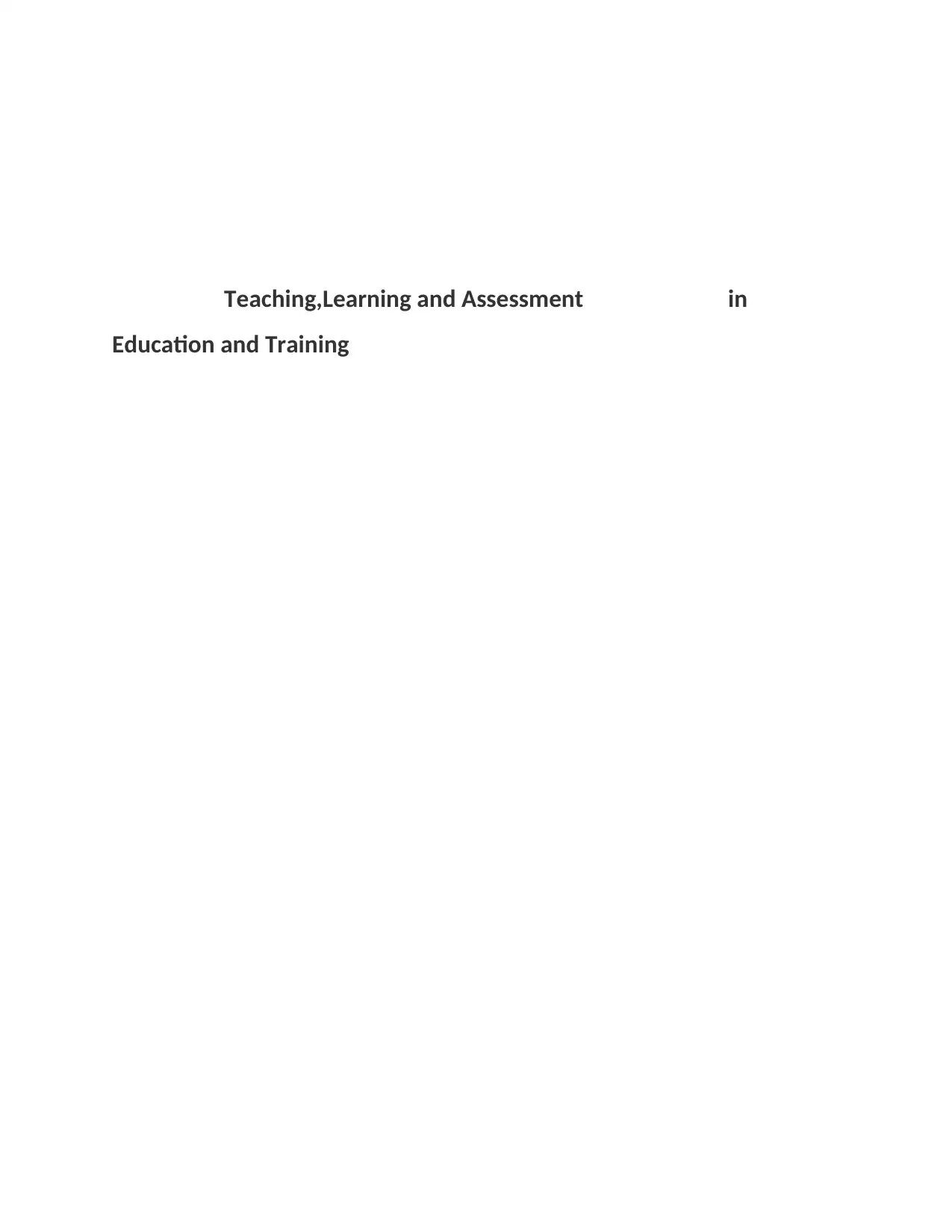
Teaching,Learning and Assessment in
Education and Training
Education and Training
Paraphrase This Document
Need a fresh take? Get an instant paraphrase of this document with our AI Paraphraser
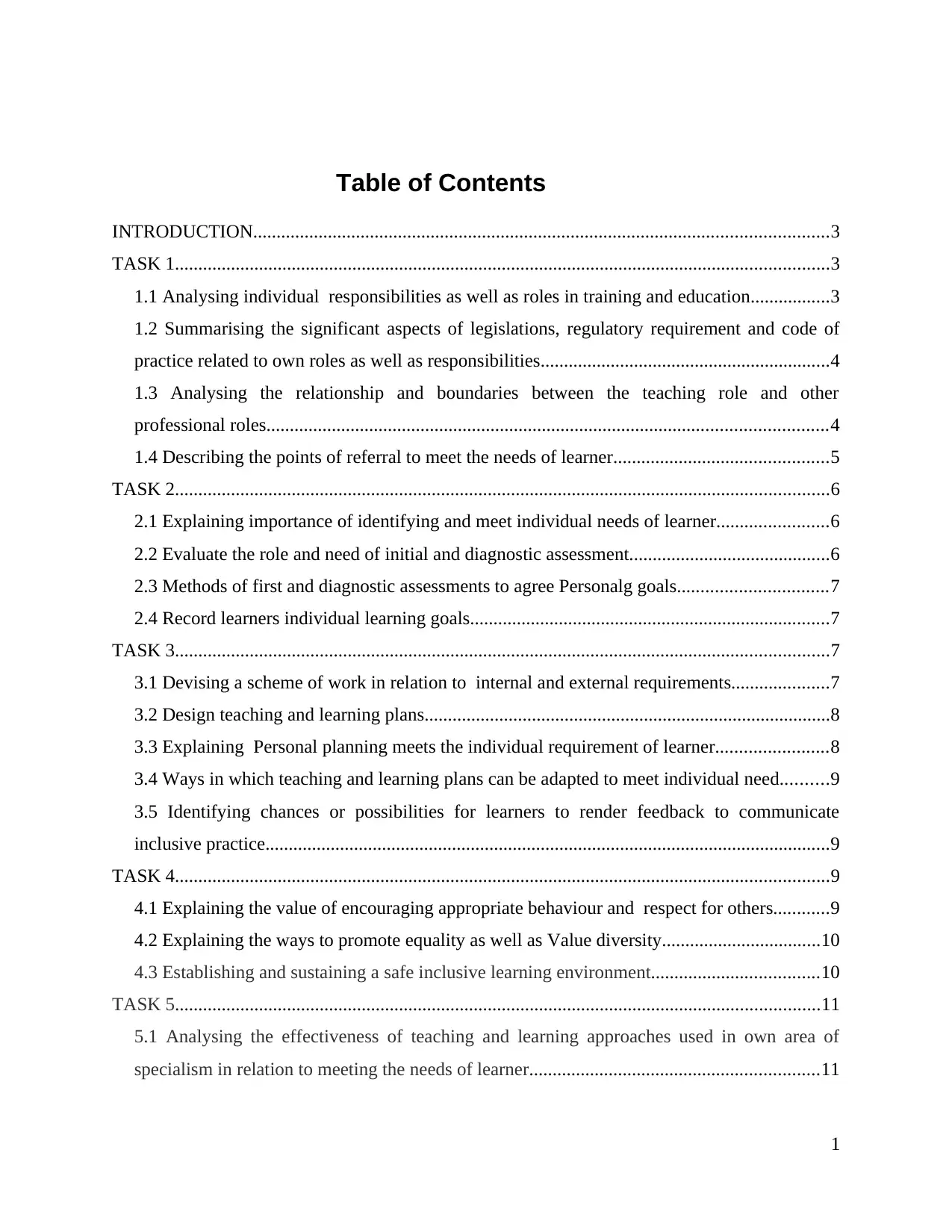
Table of Contents
INTRODUCTION...........................................................................................................................3
TASK 1............................................................................................................................................3
1.1 Analysing individual responsibilities as well as roles in training and education.................3
1.2 Summarising the significant aspects of legislations, regulatory requirement and code of
practice related to own roles as well as responsibilities..............................................................4
1.3 Analysing the relationship and boundaries between the teaching role and other
professional roles........................................................................................................................4
1.4 Describing the points of referral to meet the needs of learner..............................................5
TASK 2............................................................................................................................................6
2.1 Explaining importance of identifying and meet individual needs of learner........................6
2.2 Evaluate the role and need of initial and diagnostic assessment...........................................6
2.3 Methods of first and diagnostic assessments to agree Personalg goals................................7
2.4 Record learners individual learning goals.............................................................................7
TASK 3............................................................................................................................................7
3.1 Devising a scheme of work in relation to internal and external requirements.....................7
3.2 Design teaching and learning plans.......................................................................................8
3.3 Explaining Personal planning meets the individual requirement of learner........................8
3.4 Ways in which teaching and learning plans can be adapted to meet individual need..........9
3.5 Identifying chances or possibilities for learners to render feedback to communicate
inclusive practice.........................................................................................................................9
TASK 4............................................................................................................................................9
4.1 Explaining the value of encouraging appropriate behaviour and respect for others............9
4.2 Explaining the ways to promote equality as well as Value diversity..................................10
4.3 Establishing and sustaining a safe inclusive learning environment....................................10
TASK 5..........................................................................................................................................11
5.1 Analysing the effectiveness of teaching and learning approaches used in own area of
specialism in relation to meeting the needs of learner..............................................................11
1
INTRODUCTION...........................................................................................................................3
TASK 1............................................................................................................................................3
1.1 Analysing individual responsibilities as well as roles in training and education.................3
1.2 Summarising the significant aspects of legislations, regulatory requirement and code of
practice related to own roles as well as responsibilities..............................................................4
1.3 Analysing the relationship and boundaries between the teaching role and other
professional roles........................................................................................................................4
1.4 Describing the points of referral to meet the needs of learner..............................................5
TASK 2............................................................................................................................................6
2.1 Explaining importance of identifying and meet individual needs of learner........................6
2.2 Evaluate the role and need of initial and diagnostic assessment...........................................6
2.3 Methods of first and diagnostic assessments to agree Personalg goals................................7
2.4 Record learners individual learning goals.............................................................................7
TASK 3............................................................................................................................................7
3.1 Devising a scheme of work in relation to internal and external requirements.....................7
3.2 Design teaching and learning plans.......................................................................................8
3.3 Explaining Personal planning meets the individual requirement of learner........................8
3.4 Ways in which teaching and learning plans can be adapted to meet individual need..........9
3.5 Identifying chances or possibilities for learners to render feedback to communicate
inclusive practice.........................................................................................................................9
TASK 4............................................................................................................................................9
4.1 Explaining the value of encouraging appropriate behaviour and respect for others............9
4.2 Explaining the ways to promote equality as well as Value diversity..................................10
4.3 Establishing and sustaining a safe inclusive learning environment....................................10
TASK 5..........................................................................................................................................11
5.1 Analysing the effectiveness of teaching and learning approaches used in own area of
specialism in relation to meeting the needs of learner..............................................................11
1
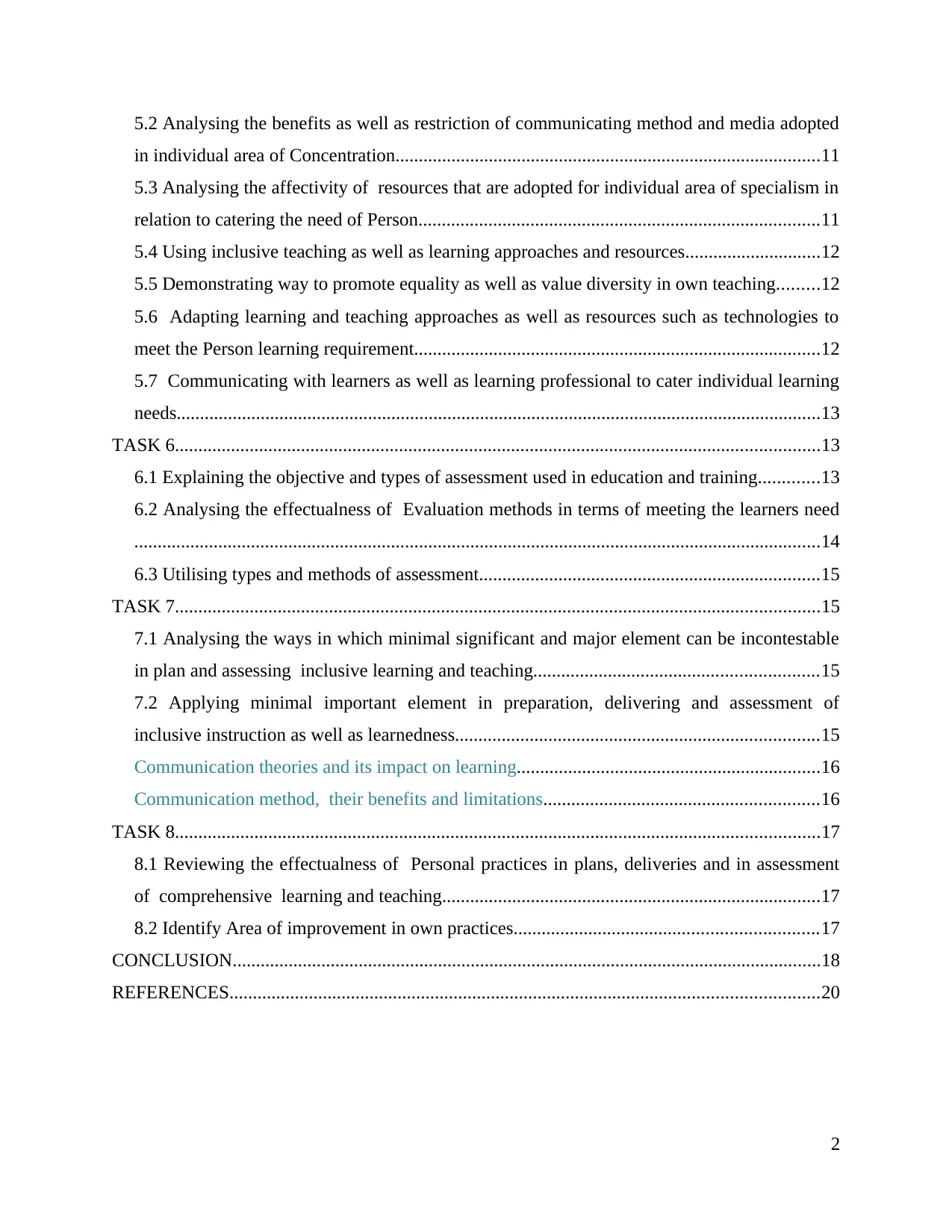
5.2 Analysing the benefits as well as restriction of communicating method and media adopted
in individual area of Concentration...........................................................................................11
5.3 Analysing the affectivity of resources that are adopted for individual area of specialism in
relation to catering the need of Person......................................................................................11
5.4 Using inclusive teaching as well as learning approaches and resources.............................12
5.5 Demonstrating way to promote equality as well as value diversity in own teaching.........12
5.6 Adapting learning and teaching approaches as well as resources such as technologies to
meet the Person learning requirement.......................................................................................12
5.7 Communicating with learners as well as learning professional to cater individual learning
needs..........................................................................................................................................13
TASK 6..........................................................................................................................................13
6.1 Explaining the objective and types of assessment used in education and training.............13
6.2 Analysing the effectualness of Evaluation methods in terms of meeting the learners need
...................................................................................................................................................14
6.3 Utilising types and methods of assessment.........................................................................15
TASK 7..........................................................................................................................................15
7.1 Analysing the ways in which minimal significant and major element can be incontestable
in plan and assessing inclusive learning and teaching.............................................................15
7.2 Applying minimal important element in preparation, delivering and assessment of
inclusive instruction as well as learnedness..............................................................................15
Communication theories and its impact on learning.................................................................16
Communication method, their benefits and limitations...........................................................16
TASK 8..........................................................................................................................................17
8.1 Reviewing the effectualness of Personal practices in plans, deliveries and in assessment
of comprehensive learning and teaching.................................................................................17
8.2 Identify Area of improvement in own practices.................................................................17
CONCLUSION..............................................................................................................................18
REFERENCES..............................................................................................................................20
2
in individual area of Concentration...........................................................................................11
5.3 Analysing the affectivity of resources that are adopted for individual area of specialism in
relation to catering the need of Person......................................................................................11
5.4 Using inclusive teaching as well as learning approaches and resources.............................12
5.5 Demonstrating way to promote equality as well as value diversity in own teaching.........12
5.6 Adapting learning and teaching approaches as well as resources such as technologies to
meet the Person learning requirement.......................................................................................12
5.7 Communicating with learners as well as learning professional to cater individual learning
needs..........................................................................................................................................13
TASK 6..........................................................................................................................................13
6.1 Explaining the objective and types of assessment used in education and training.............13
6.2 Analysing the effectualness of Evaluation methods in terms of meeting the learners need
...................................................................................................................................................14
6.3 Utilising types and methods of assessment.........................................................................15
TASK 7..........................................................................................................................................15
7.1 Analysing the ways in which minimal significant and major element can be incontestable
in plan and assessing inclusive learning and teaching.............................................................15
7.2 Applying minimal important element in preparation, delivering and assessment of
inclusive instruction as well as learnedness..............................................................................15
Communication theories and its impact on learning.................................................................16
Communication method, their benefits and limitations...........................................................16
TASK 8..........................................................................................................................................17
8.1 Reviewing the effectualness of Personal practices in plans, deliveries and in assessment
of comprehensive learning and teaching.................................................................................17
8.2 Identify Area of improvement in own practices.................................................................17
CONCLUSION..............................................................................................................................18
REFERENCES..............................................................................................................................20
2
⊘ This is a preview!⊘
Do you want full access?
Subscribe today to unlock all pages.

Trusted by 1+ million students worldwide
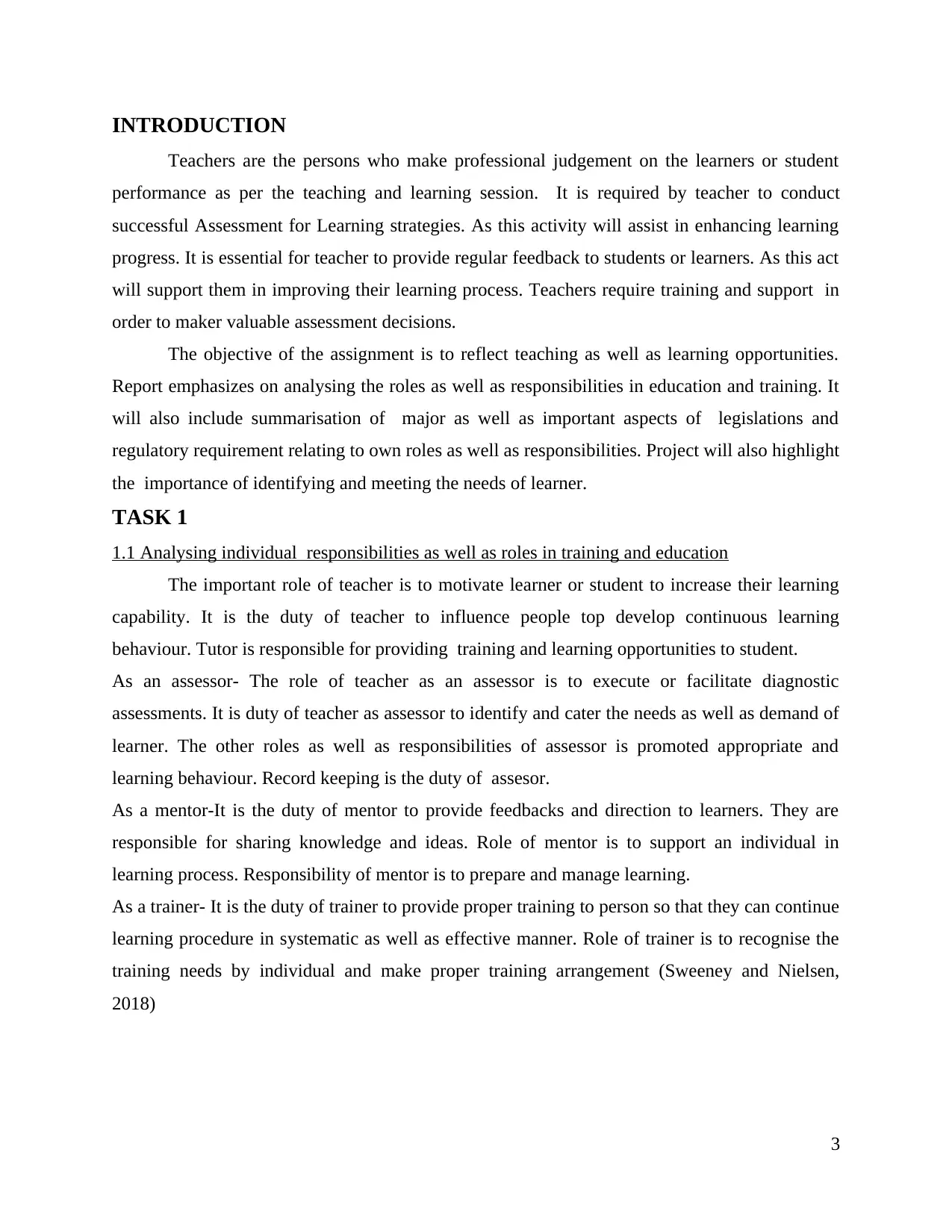
INTRODUCTION
Teachers are the persons who make professional judgement on the learners or student
performance as per the teaching and learning session. It is required by teacher to conduct
successful Assessment for Learning strategies. As this activity will assist in enhancing learning
progress. It is essential for teacher to provide regular feedback to students or learners. As this act
will support them in improving their learning process. Teachers require training and support in
order to maker valuable assessment decisions.
The objective of the assignment is to reflect teaching as well as learning opportunities.
Report emphasizes on analysing the roles as well as responsibilities in education and training. It
will also include summarisation of major as well as important aspects of legislations and
regulatory requirement relating to own roles as well as responsibilities. Project will also highlight
the importance of identifying and meeting the needs of learner.
TASK 1
1.1 Analysing individual responsibilities as well as roles in training and education
The important role of teacher is to motivate learner or student to increase their learning
capability. It is the duty of teacher to influence people top develop continuous learning
behaviour. Tutor is responsible for providing training and learning opportunities to student.
As an assessor- The role of teacher as an assessor is to execute or facilitate diagnostic
assessments. It is duty of teacher as assessor to identify and cater the needs as well as demand of
learner. The other roles as well as responsibilities of assessor is promoted appropriate and
learning behaviour. Record keeping is the duty of assesor.
As a mentor-It is the duty of mentor to provide feedbacks and direction to learners. They are
responsible for sharing knowledge and ideas. Role of mentor is to support an individual in
learning process. Responsibility of mentor is to prepare and manage learning.
As a trainer- It is the duty of trainer to provide proper training to person so that they can continue
learning procedure in systematic as well as effective manner. Role of trainer is to recognise the
training needs by individual and make proper training arrangement (Sweeney and Nielsen,
2018)
3
Teachers are the persons who make professional judgement on the learners or student
performance as per the teaching and learning session. It is required by teacher to conduct
successful Assessment for Learning strategies. As this activity will assist in enhancing learning
progress. It is essential for teacher to provide regular feedback to students or learners. As this act
will support them in improving their learning process. Teachers require training and support in
order to maker valuable assessment decisions.
The objective of the assignment is to reflect teaching as well as learning opportunities.
Report emphasizes on analysing the roles as well as responsibilities in education and training. It
will also include summarisation of major as well as important aspects of legislations and
regulatory requirement relating to own roles as well as responsibilities. Project will also highlight
the importance of identifying and meeting the needs of learner.
TASK 1
1.1 Analysing individual responsibilities as well as roles in training and education
The important role of teacher is to motivate learner or student to increase their learning
capability. It is the duty of teacher to influence people top develop continuous learning
behaviour. Tutor is responsible for providing training and learning opportunities to student.
As an assessor- The role of teacher as an assessor is to execute or facilitate diagnostic
assessments. It is duty of teacher as assessor to identify and cater the needs as well as demand of
learner. The other roles as well as responsibilities of assessor is promoted appropriate and
learning behaviour. Record keeping is the duty of assesor.
As a mentor-It is the duty of mentor to provide feedbacks and direction to learners. They are
responsible for sharing knowledge and ideas. Role of mentor is to support an individual in
learning process. Responsibility of mentor is to prepare and manage learning.
As a trainer- It is the duty of trainer to provide proper training to person so that they can continue
learning procedure in systematic as well as effective manner. Role of trainer is to recognise the
training needs by individual and make proper training arrangement (Sweeney and Nielsen,
2018)
3
Paraphrase This Document
Need a fresh take? Get an instant paraphrase of this document with our AI Paraphraser
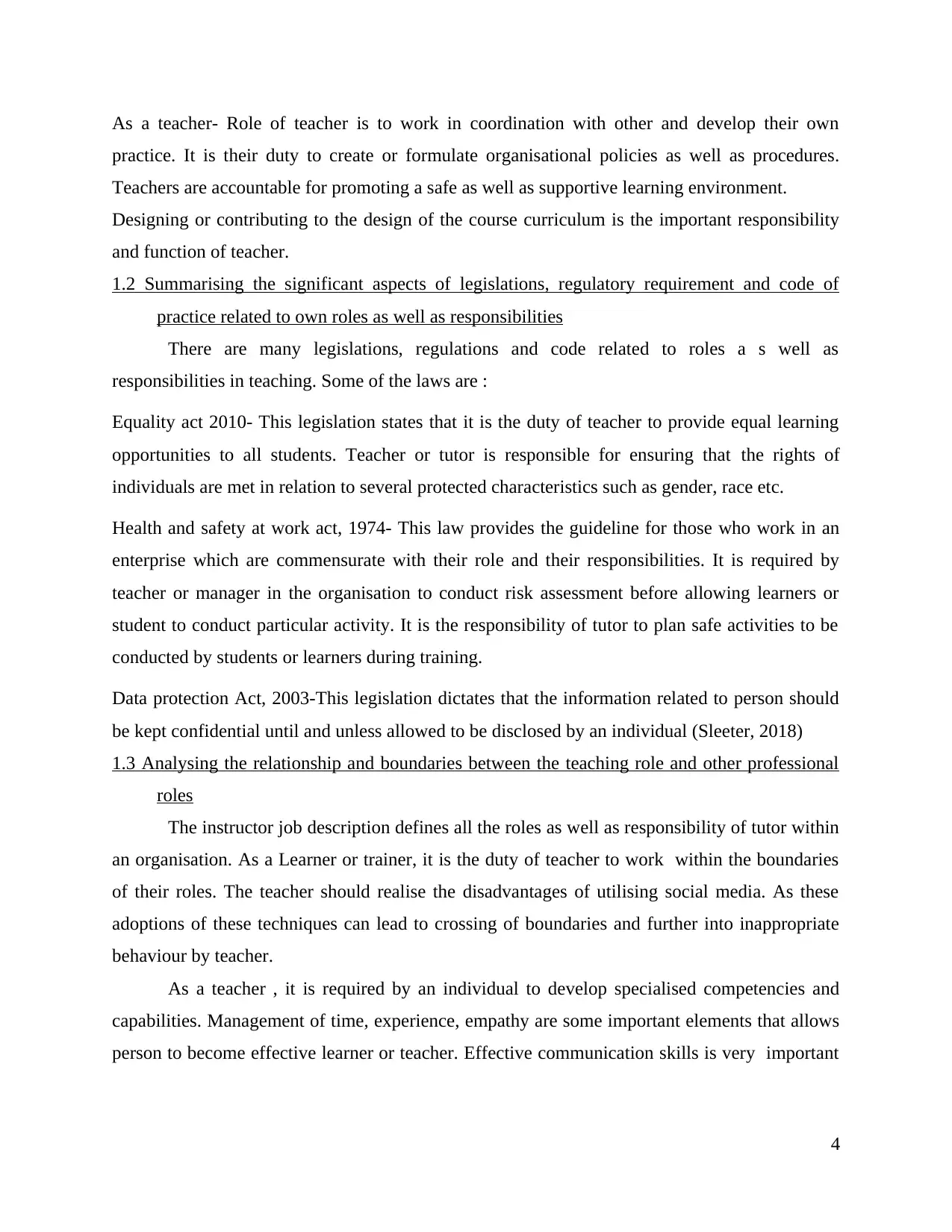
As a teacher- Role of teacher is to work in coordination with other and develop their own
practice. It is their duty to create or formulate organisational policies as well as procedures.
Teachers are accountable for promoting a safe as well as supportive learning environment.
Designing or contributing to the design of the course curriculum is the important responsibility
and function of teacher.
1.2 Summarising the significant aspects of legislations, regulatory requirement and code of
practice related to own roles as well as responsibilities
There are many legislations, regulations and code related to roles a s well as
responsibilities in teaching. Some of the laws are :
Equality act 2010- This legislation states that it is the duty of teacher to provide equal learning
opportunities to all students. Teacher or tutor is responsible for ensuring that the rights of
individuals are met in relation to several protected characteristics such as gender, race etc.
Health and safety at work act, 1974- This law provides the guideline for those who work in an
enterprise which are commensurate with their role and their responsibilities. It is required by
teacher or manager in the organisation to conduct risk assessment before allowing learners or
student to conduct particular activity. It is the responsibility of tutor to plan safe activities to be
conducted by students or learners during training.
Data protection Act, 2003-This legislation dictates that the information related to person should
be kept confidential until and unless allowed to be disclosed by an individual (Sleeter, 2018)
1.3 Analysing the relationship and boundaries between the teaching role and other professional
roles
The instructor job description defines all the roles as well as responsibility of tutor within
an organisation. As a Learner or trainer, it is the duty of teacher to work within the boundaries
of their roles. The teacher should realise the disadvantages of utilising social media. As these
adoptions of these techniques can lead to crossing of boundaries and further into inappropriate
behaviour by teacher.
As a teacher , it is required by an individual to develop specialised competencies and
capabilities. Management of time, experience, empathy are some important elements that allows
person to become effective learner or teacher. Effective communication skills is very important
4
practice. It is their duty to create or formulate organisational policies as well as procedures.
Teachers are accountable for promoting a safe as well as supportive learning environment.
Designing or contributing to the design of the course curriculum is the important responsibility
and function of teacher.
1.2 Summarising the significant aspects of legislations, regulatory requirement and code of
practice related to own roles as well as responsibilities
There are many legislations, regulations and code related to roles a s well as
responsibilities in teaching. Some of the laws are :
Equality act 2010- This legislation states that it is the duty of teacher to provide equal learning
opportunities to all students. Teacher or tutor is responsible for ensuring that the rights of
individuals are met in relation to several protected characteristics such as gender, race etc.
Health and safety at work act, 1974- This law provides the guideline for those who work in an
enterprise which are commensurate with their role and their responsibilities. It is required by
teacher or manager in the organisation to conduct risk assessment before allowing learners or
student to conduct particular activity. It is the responsibility of tutor to plan safe activities to be
conducted by students or learners during training.
Data protection Act, 2003-This legislation dictates that the information related to person should
be kept confidential until and unless allowed to be disclosed by an individual (Sleeter, 2018)
1.3 Analysing the relationship and boundaries between the teaching role and other professional
roles
The instructor job description defines all the roles as well as responsibility of tutor within
an organisation. As a Learner or trainer, it is the duty of teacher to work within the boundaries
of their roles. The teacher should realise the disadvantages of utilising social media. As these
adoptions of these techniques can lead to crossing of boundaries and further into inappropriate
behaviour by teacher.
As a teacher , it is required by an individual to develop specialised competencies and
capabilities. Management of time, experience, empathy are some important elements that allows
person to become effective learner or teacher. Effective communication skills is very important
4
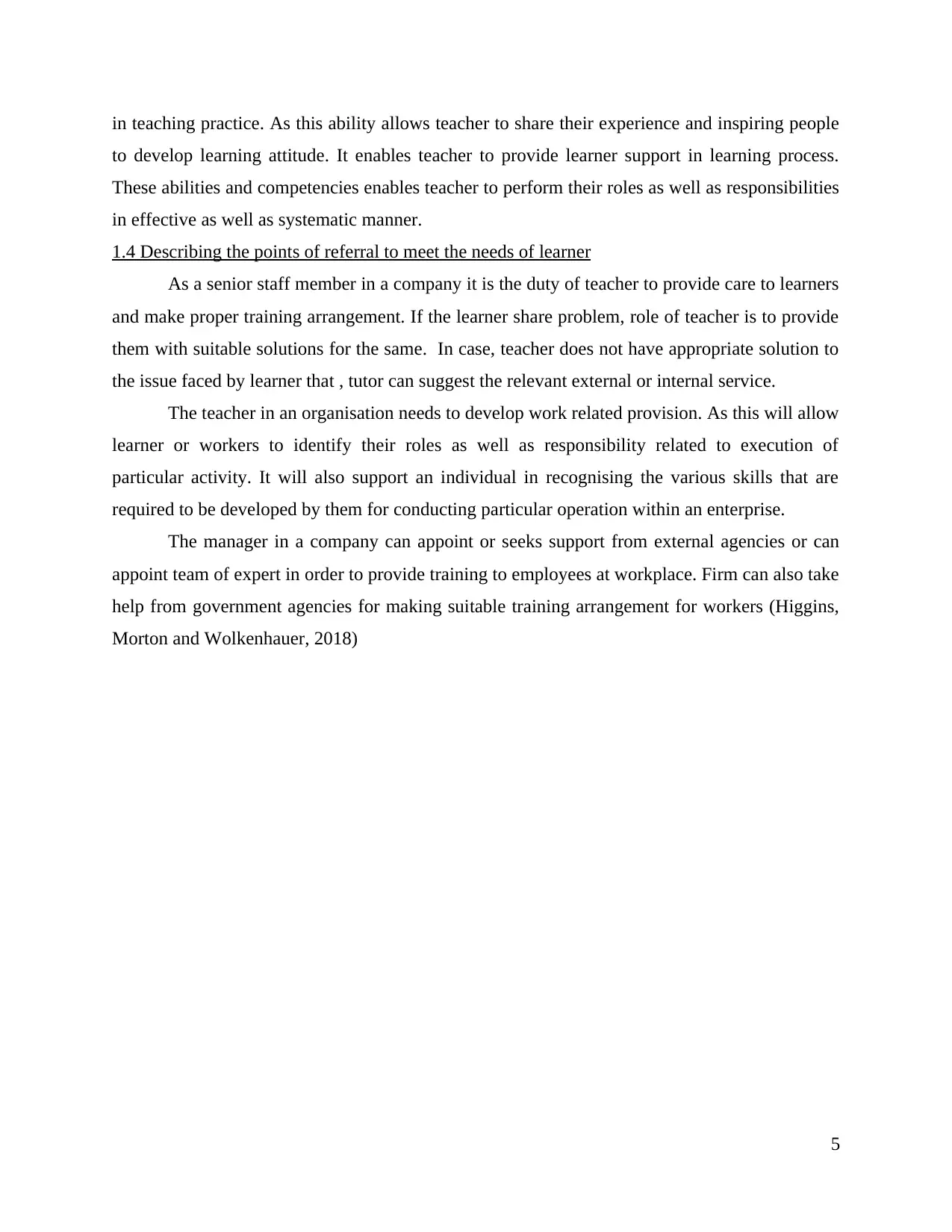
in teaching practice. As this ability allows teacher to share their experience and inspiring people
to develop learning attitude. It enables teacher to provide learner support in learning process.
These abilities and competencies enables teacher to perform their roles as well as responsibilities
in effective as well as systematic manner.
1.4 Describing the points of referral to meet the needs of learner
As a senior staff member in a company it is the duty of teacher to provide care to learners
and make proper training arrangement. If the learner share problem, role of teacher is to provide
them with suitable solutions for the same. In case, teacher does not have appropriate solution to
the issue faced by learner that , tutor can suggest the relevant external or internal service.
The teacher in an organisation needs to develop work related provision. As this will allow
learner or workers to identify their roles as well as responsibility related to execution of
particular activity. It will also support an individual in recognising the various skills that are
required to be developed by them for conducting particular operation within an enterprise.
The manager in a company can appoint or seeks support from external agencies or can
appoint team of expert in order to provide training to employees at workplace. Firm can also take
help from government agencies for making suitable training arrangement for workers (Higgins,
Morton and Wolkenhauer, 2018)
5
to develop learning attitude. It enables teacher to provide learner support in learning process.
These abilities and competencies enables teacher to perform their roles as well as responsibilities
in effective as well as systematic manner.
1.4 Describing the points of referral to meet the needs of learner
As a senior staff member in a company it is the duty of teacher to provide care to learners
and make proper training arrangement. If the learner share problem, role of teacher is to provide
them with suitable solutions for the same. In case, teacher does not have appropriate solution to
the issue faced by learner that , tutor can suggest the relevant external or internal service.
The teacher in an organisation needs to develop work related provision. As this will allow
learner or workers to identify their roles as well as responsibility related to execution of
particular activity. It will also support an individual in recognising the various skills that are
required to be developed by them for conducting particular operation within an enterprise.
The manager in a company can appoint or seeks support from external agencies or can
appoint team of expert in order to provide training to employees at workplace. Firm can also take
help from government agencies for making suitable training arrangement for workers (Higgins,
Morton and Wolkenhauer, 2018)
5
⊘ This is a preview!⊘
Do you want full access?
Subscribe today to unlock all pages.

Trusted by 1+ million students worldwide
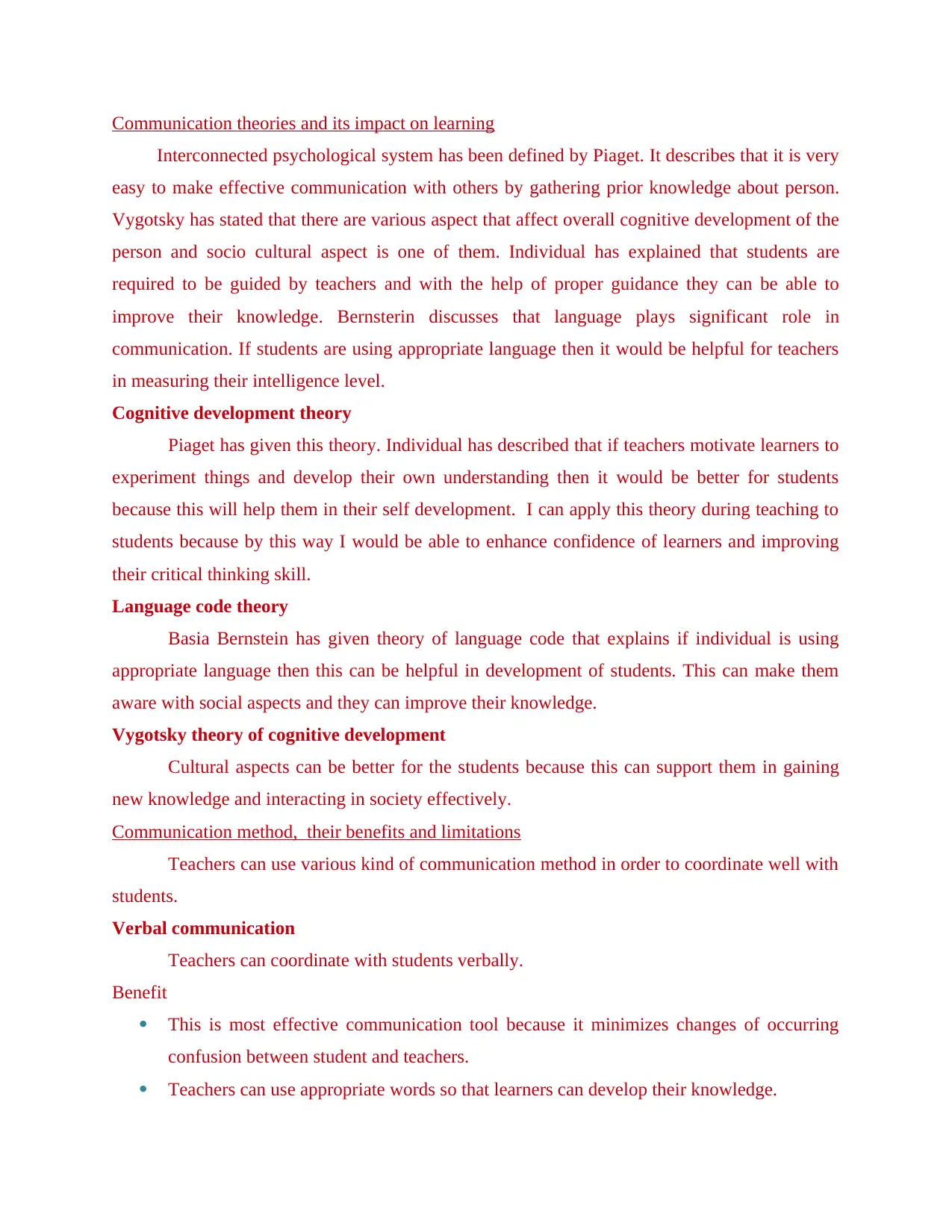
Communication theories and its impact on learning
Interconnected psychological system has been defined by Piaget. It describes that it is very
easy to make effective communication with others by gathering prior knowledge about person.
Vygotsky has stated that there are various aspect that affect overall cognitive development of the
person and socio cultural aspect is one of them. Individual has explained that students are
required to be guided by teachers and with the help of proper guidance they can be able to
improve their knowledge. Bernsterin discusses that language plays significant role in
communication. If students are using appropriate language then it would be helpful for teachers
in measuring their intelligence level.
Cognitive development theory
Piaget has given this theory. Individual has described that if teachers motivate learners to
experiment things and develop their own understanding then it would be better for students
because this will help them in their self development. I can apply this theory during teaching to
students because by this way I would be able to enhance confidence of learners and improving
their critical thinking skill.
Language code theory
Basia Bernstein has given theory of language code that explains if individual is using
appropriate language then this can be helpful in development of students. This can make them
aware with social aspects and they can improve their knowledge.
Vygotsky theory of cognitive development
Cultural aspects can be better for the students because this can support them in gaining
new knowledge and interacting in society effectively.
Communication method, their benefits and limitations
Teachers can use various kind of communication method in order to coordinate well with
students.
Verbal communication
Teachers can coordinate with students verbally.
Benefit
This is most effective communication tool because it minimizes changes of occurring
confusion between student and teachers.
Teachers can use appropriate words so that learners can develop their knowledge.
Interconnected psychological system has been defined by Piaget. It describes that it is very
easy to make effective communication with others by gathering prior knowledge about person.
Vygotsky has stated that there are various aspect that affect overall cognitive development of the
person and socio cultural aspect is one of them. Individual has explained that students are
required to be guided by teachers and with the help of proper guidance they can be able to
improve their knowledge. Bernsterin discusses that language plays significant role in
communication. If students are using appropriate language then it would be helpful for teachers
in measuring their intelligence level.
Cognitive development theory
Piaget has given this theory. Individual has described that if teachers motivate learners to
experiment things and develop their own understanding then it would be better for students
because this will help them in their self development. I can apply this theory during teaching to
students because by this way I would be able to enhance confidence of learners and improving
their critical thinking skill.
Language code theory
Basia Bernstein has given theory of language code that explains if individual is using
appropriate language then this can be helpful in development of students. This can make them
aware with social aspects and they can improve their knowledge.
Vygotsky theory of cognitive development
Cultural aspects can be better for the students because this can support them in gaining
new knowledge and interacting in society effectively.
Communication method, their benefits and limitations
Teachers can use various kind of communication method in order to coordinate well with
students.
Verbal communication
Teachers can coordinate with students verbally.
Benefit
This is most effective communication tool because it minimizes changes of occurring
confusion between student and teachers.
Teachers can use appropriate words so that learners can develop their knowledge.
Paraphrase This Document
Need a fresh take? Get an instant paraphrase of this document with our AI Paraphraser
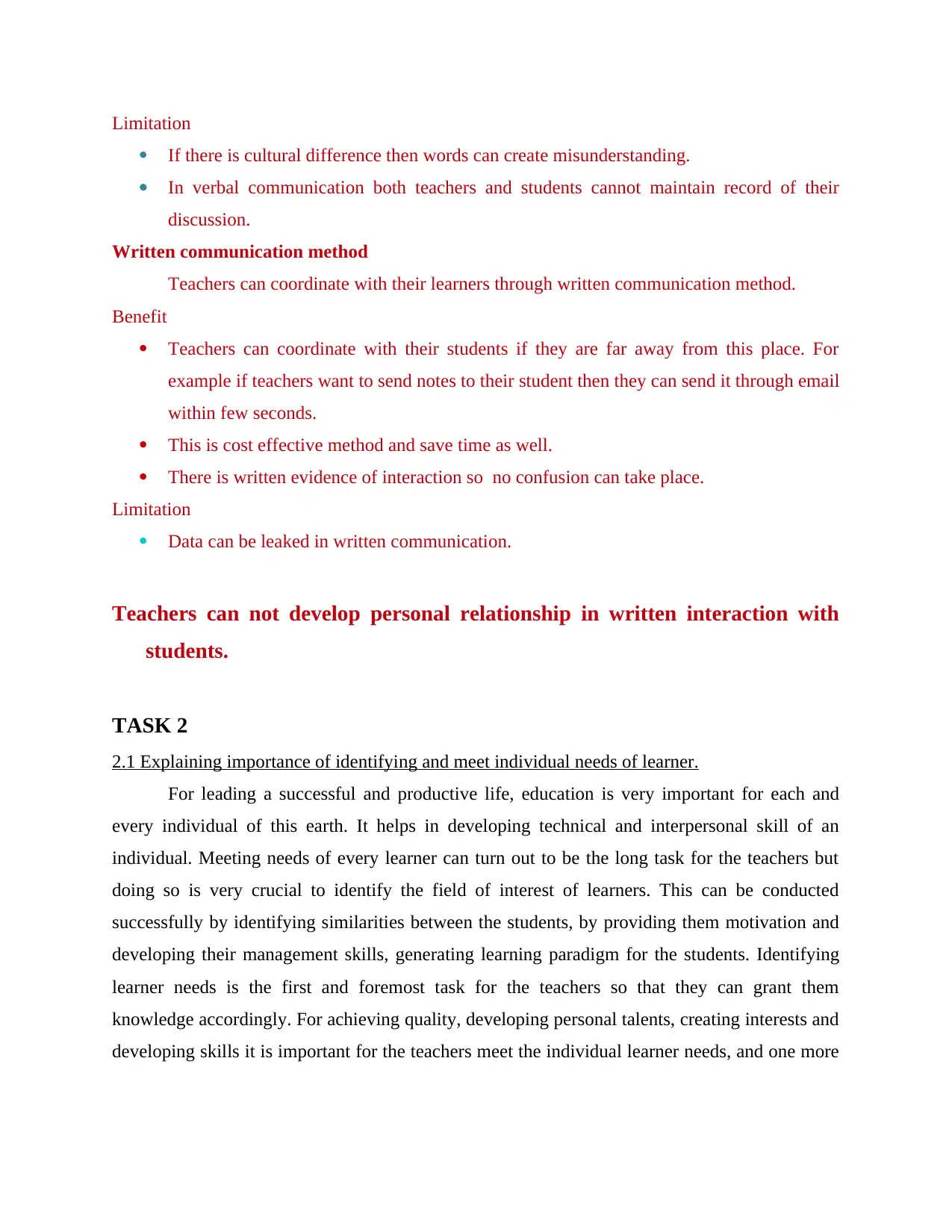
Limitation
If there is cultural difference then words can create misunderstanding.
In verbal communication both teachers and students cannot maintain record of their
discussion.
Written communication method
Teachers can coordinate with their learners through written communication method.
Benefit
Teachers can coordinate with their students if they are far away from this place. For
example if teachers want to send notes to their student then they can send it through email
within few seconds.
This is cost effective method and save time as well.
There is written evidence of interaction so no confusion can take place.
Limitation
Data can be leaked in written communication.
Teachers can not develop personal relationship in written interaction with
students.
TASK 2
2.1 Explaining importance of identifying and meet individual needs of learner.
For leading a successful and productive life, education is very important for each and
every individual of this earth. It helps in developing technical and interpersonal skill of an
individual. Meeting needs of every learner can turn out to be the long task for the teachers but
doing so is very crucial to identify the field of interest of learners. This can be conducted
successfully by identifying similarities between the students, by providing them motivation and
developing their management skills, generating learning paradigm for the students. Identifying
learner needs is the first and foremost task for the teachers so that they can grant them
knowledge accordingly. For achieving quality, developing personal talents, creating interests and
developing skills it is important for the teachers meet the individual learner needs, and one more
If there is cultural difference then words can create misunderstanding.
In verbal communication both teachers and students cannot maintain record of their
discussion.
Written communication method
Teachers can coordinate with their learners through written communication method.
Benefit
Teachers can coordinate with their students if they are far away from this place. For
example if teachers want to send notes to their student then they can send it through email
within few seconds.
This is cost effective method and save time as well.
There is written evidence of interaction so no confusion can take place.
Limitation
Data can be leaked in written communication.
Teachers can not develop personal relationship in written interaction with
students.
TASK 2
2.1 Explaining importance of identifying and meet individual needs of learner.
For leading a successful and productive life, education is very important for each and
every individual of this earth. It helps in developing technical and interpersonal skill of an
individual. Meeting needs of every learner can turn out to be the long task for the teachers but
doing so is very crucial to identify the field of interest of learners. This can be conducted
successfully by identifying similarities between the students, by providing them motivation and
developing their management skills, generating learning paradigm for the students. Identifying
learner needs is the first and foremost task for the teachers so that they can grant them
knowledge accordingly. For achieving quality, developing personal talents, creating interests and
developing skills it is important for the teachers meet the individual learner needs, and one more
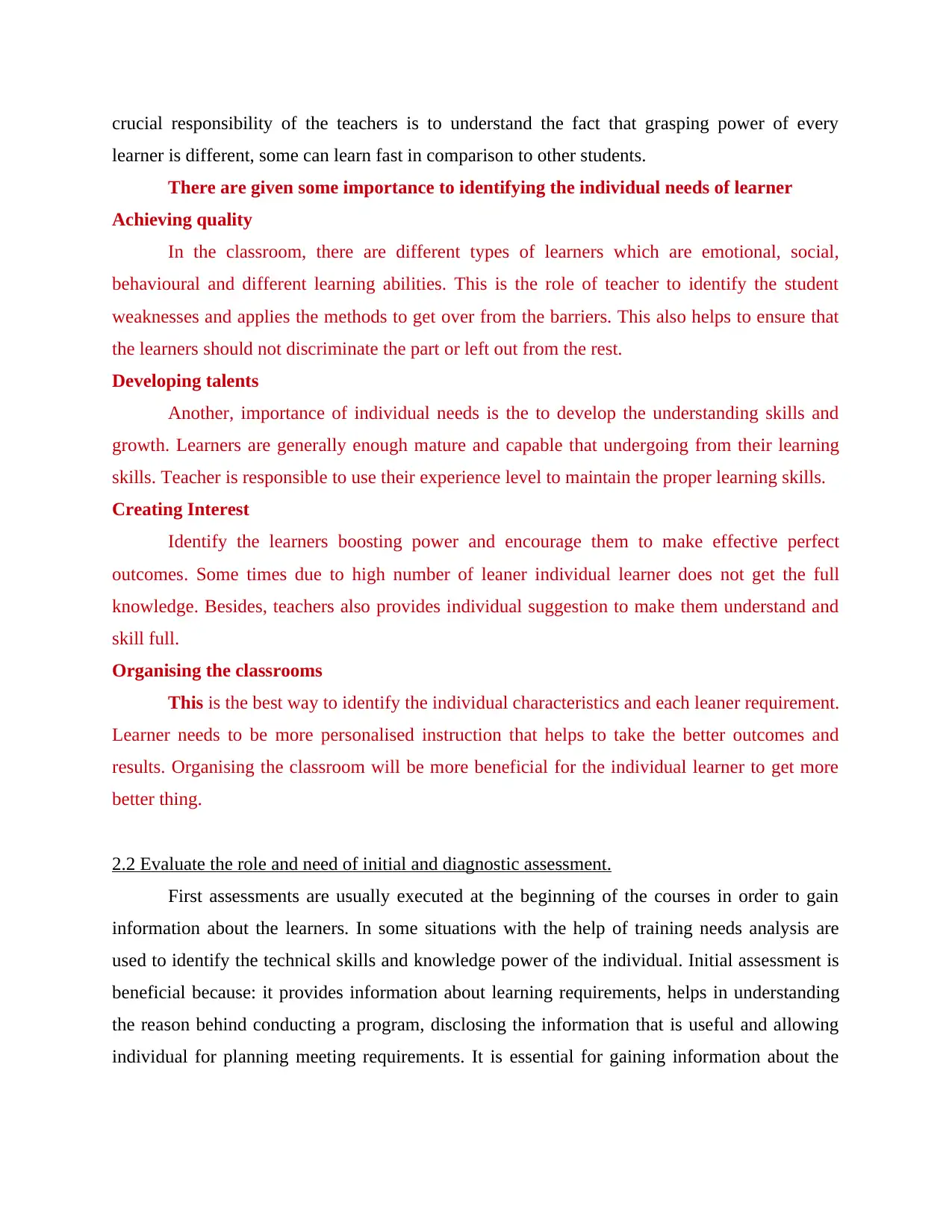
crucial responsibility of the teachers is to understand the fact that grasping power of every
learner is different, some can learn fast in comparison to other students.
There are given some importance to identifying the individual needs of learner
Achieving quality
In the classroom, there are different types of learners which are emotional, social,
behavioural and different learning abilities. This is the role of teacher to identify the student
weaknesses and applies the methods to get over from the barriers. This also helps to ensure that
the learners should not discriminate the part or left out from the rest.
Developing talents
Another, importance of individual needs is the to develop the understanding skills and
growth. Learners are generally enough mature and capable that undergoing from their learning
skills. Teacher is responsible to use their experience level to maintain the proper learning skills.
Creating Interest
Identify the learners boosting power and encourage them to make effective perfect
outcomes. Some times due to high number of leaner individual learner does not get the full
knowledge. Besides, teachers also provides individual suggestion to make them understand and
skill full.
Organising the classrooms
This is the best way to identify the individual characteristics and each leaner requirement.
Learner needs to be more personalised instruction that helps to take the better outcomes and
results. Organising the classroom will be more beneficial for the individual learner to get more
better thing.
2.2 Evaluate the role and need of initial and diagnostic assessment.
First assessments are usually executed at the beginning of the courses in order to gain
information about the learners. In some situations with the help of training needs analysis are
used to identify the technical skills and knowledge power of the individual. Initial assessment is
beneficial because: it provides information about learning requirements, helps in understanding
the reason behind conducting a program, disclosing the information that is useful and allowing
individual for planning meeting requirements. It is essential for gaining information about the
learner is different, some can learn fast in comparison to other students.
There are given some importance to identifying the individual needs of learner
Achieving quality
In the classroom, there are different types of learners which are emotional, social,
behavioural and different learning abilities. This is the role of teacher to identify the student
weaknesses and applies the methods to get over from the barriers. This also helps to ensure that
the learners should not discriminate the part or left out from the rest.
Developing talents
Another, importance of individual needs is the to develop the understanding skills and
growth. Learners are generally enough mature and capable that undergoing from their learning
skills. Teacher is responsible to use their experience level to maintain the proper learning skills.
Creating Interest
Identify the learners boosting power and encourage them to make effective perfect
outcomes. Some times due to high number of leaner individual learner does not get the full
knowledge. Besides, teachers also provides individual suggestion to make them understand and
skill full.
Organising the classrooms
This is the best way to identify the individual characteristics and each leaner requirement.
Learner needs to be more personalised instruction that helps to take the better outcomes and
results. Organising the classroom will be more beneficial for the individual learner to get more
better thing.
2.2 Evaluate the role and need of initial and diagnostic assessment.
First assessments are usually executed at the beginning of the courses in order to gain
information about the learners. In some situations with the help of training needs analysis are
used to identify the technical skills and knowledge power of the individual. Initial assessment is
beneficial because: it provides information about learning requirements, helps in understanding
the reason behind conducting a program, disclosing the information that is useful and allowing
individual for planning meeting requirements. It is essential for gaining information about the
⊘ This is a preview!⊘
Do you want full access?
Subscribe today to unlock all pages.

Trusted by 1+ million students worldwide
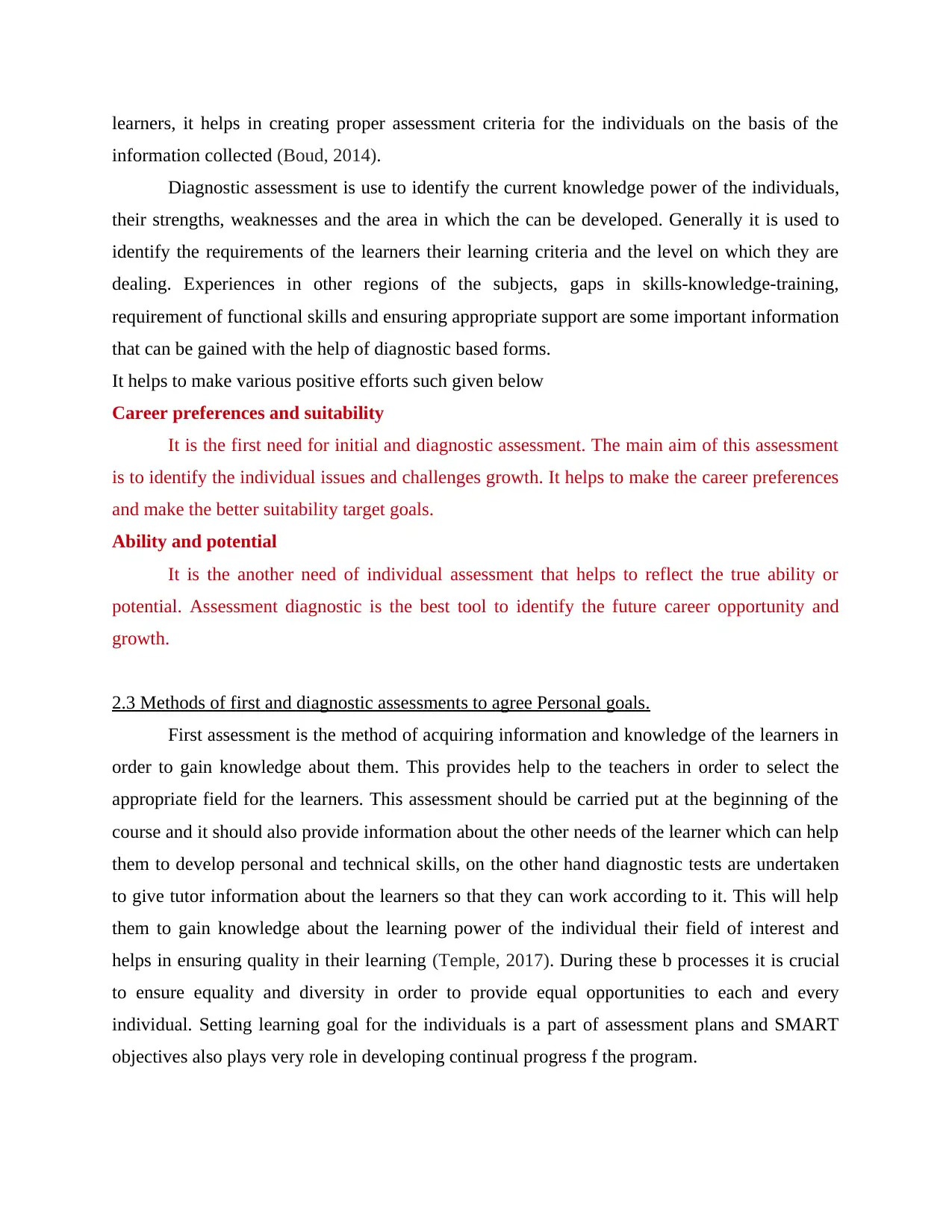
learners, it helps in creating proper assessment criteria for the individuals on the basis of the
information collected (Boud, 2014).
Diagnostic assessment is use to identify the current knowledge power of the individuals,
their strengths, weaknesses and the area in which the can be developed. Generally it is used to
identify the requirements of the learners their learning criteria and the level on which they are
dealing. Experiences in other regions of the subjects, gaps in skills-knowledge-training,
requirement of functional skills and ensuring appropriate support are some important information
that can be gained with the help of diagnostic based forms.
It helps to make various positive efforts such given below
Career preferences and suitability
It is the first need for initial and diagnostic assessment. The main aim of this assessment
is to identify the individual issues and challenges growth. It helps to make the career preferences
and make the better suitability target goals.
Ability and potential
It is the another need of individual assessment that helps to reflect the true ability or
potential. Assessment diagnostic is the best tool to identify the future career opportunity and
growth.
2.3 Methods of first and diagnostic assessments to agree Personal goals.
First assessment is the method of acquiring information and knowledge of the learners in
order to gain knowledge about them. This provides help to the teachers in order to select the
appropriate field for the learners. This assessment should be carried put at the beginning of the
course and it should also provide information about the other needs of the learner which can help
them to develop personal and technical skills, on the other hand diagnostic tests are undertaken
to give tutor information about the learners so that they can work according to it. This will help
them to gain knowledge about the learning power of the individual their field of interest and
helps in ensuring quality in their learning (Temple, 2017). During these b processes it is crucial
to ensure equality and diversity in order to provide equal opportunities to each and every
individual. Setting learning goal for the individuals is a part of assessment plans and SMART
objectives also plays very role in developing continual progress f the program.
information collected (Boud, 2014).
Diagnostic assessment is use to identify the current knowledge power of the individuals,
their strengths, weaknesses and the area in which the can be developed. Generally it is used to
identify the requirements of the learners their learning criteria and the level on which they are
dealing. Experiences in other regions of the subjects, gaps in skills-knowledge-training,
requirement of functional skills and ensuring appropriate support are some important information
that can be gained with the help of diagnostic based forms.
It helps to make various positive efforts such given below
Career preferences and suitability
It is the first need for initial and diagnostic assessment. The main aim of this assessment
is to identify the individual issues and challenges growth. It helps to make the career preferences
and make the better suitability target goals.
Ability and potential
It is the another need of individual assessment that helps to reflect the true ability or
potential. Assessment diagnostic is the best tool to identify the future career opportunity and
growth.
2.3 Methods of first and diagnostic assessments to agree Personal goals.
First assessment is the method of acquiring information and knowledge of the learners in
order to gain knowledge about them. This provides help to the teachers in order to select the
appropriate field for the learners. This assessment should be carried put at the beginning of the
course and it should also provide information about the other needs of the learner which can help
them to develop personal and technical skills, on the other hand diagnostic tests are undertaken
to give tutor information about the learners so that they can work according to it. This will help
them to gain knowledge about the learning power of the individual their field of interest and
helps in ensuring quality in their learning (Temple, 2017). During these b processes it is crucial
to ensure equality and diversity in order to provide equal opportunities to each and every
individual. Setting learning goal for the individuals is a part of assessment plans and SMART
objectives also plays very role in developing continual progress f the program.
Paraphrase This Document
Need a fresh take? Get an instant paraphrase of this document with our AI Paraphraser
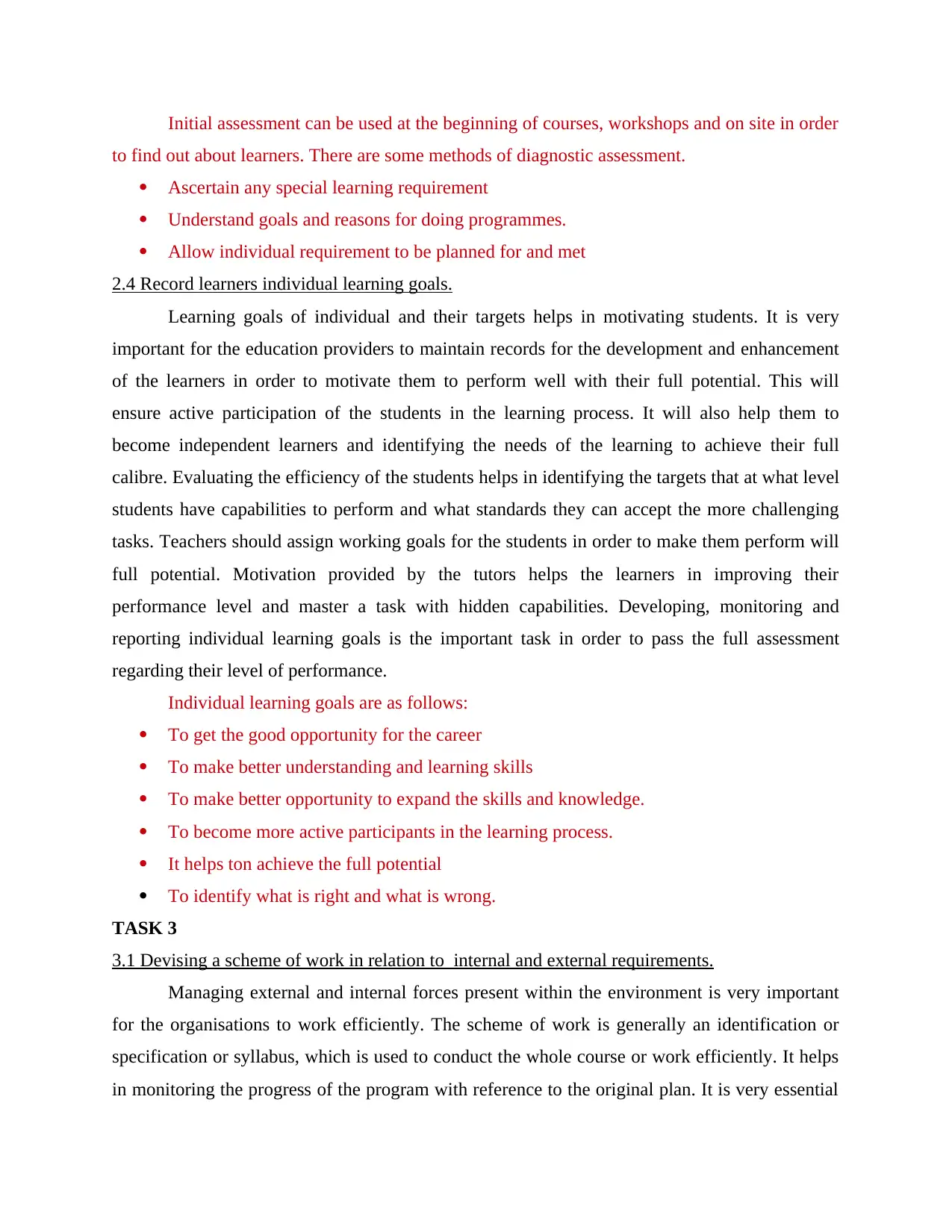
Initial assessment can be used at the beginning of courses, workshops and on site in order
to find out about learners. There are some methods of diagnostic assessment.
Ascertain any special learning requirement
Understand goals and reasons for doing programmes.
Allow individual requirement to be planned for and met
2.4 Record learners individual learning goals.
Learning goals of individual and their targets helps in motivating students. It is very
important for the education providers to maintain records for the development and enhancement
of the learners in order to motivate them to perform well with their full potential. This will
ensure active participation of the students in the learning process. It will also help them to
become independent learners and identifying the needs of the learning to achieve their full
calibre. Evaluating the efficiency of the students helps in identifying the targets that at what level
students have capabilities to perform and what standards they can accept the more challenging
tasks. Teachers should assign working goals for the students in order to make them perform will
full potential. Motivation provided by the tutors helps the learners in improving their
performance level and master a task with hidden capabilities. Developing, monitoring and
reporting individual learning goals is the important task in order to pass the full assessment
regarding their level of performance.
Individual learning goals are as follows:
To get the good opportunity for the career
To make better understanding and learning skills
To make better opportunity to expand the skills and knowledge.
To become more active participants in the learning process.
It helps ton achieve the full potential
To identify what is right and what is wrong.
TASK 3
3.1 Devising a scheme of work in relation to internal and external requirements.
Managing external and internal forces present within the environment is very important
for the organisations to work efficiently. The scheme of work is generally an identification or
specification or syllabus, which is used to conduct the whole course or work efficiently. It helps
in monitoring the progress of the program with reference to the original plan. It is very essential
to find out about learners. There are some methods of diagnostic assessment.
Ascertain any special learning requirement
Understand goals and reasons for doing programmes.
Allow individual requirement to be planned for and met
2.4 Record learners individual learning goals.
Learning goals of individual and their targets helps in motivating students. It is very
important for the education providers to maintain records for the development and enhancement
of the learners in order to motivate them to perform well with their full potential. This will
ensure active participation of the students in the learning process. It will also help them to
become independent learners and identifying the needs of the learning to achieve their full
calibre. Evaluating the efficiency of the students helps in identifying the targets that at what level
students have capabilities to perform and what standards they can accept the more challenging
tasks. Teachers should assign working goals for the students in order to make them perform will
full potential. Motivation provided by the tutors helps the learners in improving their
performance level and master a task with hidden capabilities. Developing, monitoring and
reporting individual learning goals is the important task in order to pass the full assessment
regarding their level of performance.
Individual learning goals are as follows:
To get the good opportunity for the career
To make better understanding and learning skills
To make better opportunity to expand the skills and knowledge.
To become more active participants in the learning process.
It helps ton achieve the full potential
To identify what is right and what is wrong.
TASK 3
3.1 Devising a scheme of work in relation to internal and external requirements.
Managing external and internal forces present within the environment is very important
for the organisations to work efficiently. The scheme of work is generally an identification or
specification or syllabus, which is used to conduct the whole course or work efficiently. It helps
in monitoring the progress of the program with reference to the original plan. It is very essential
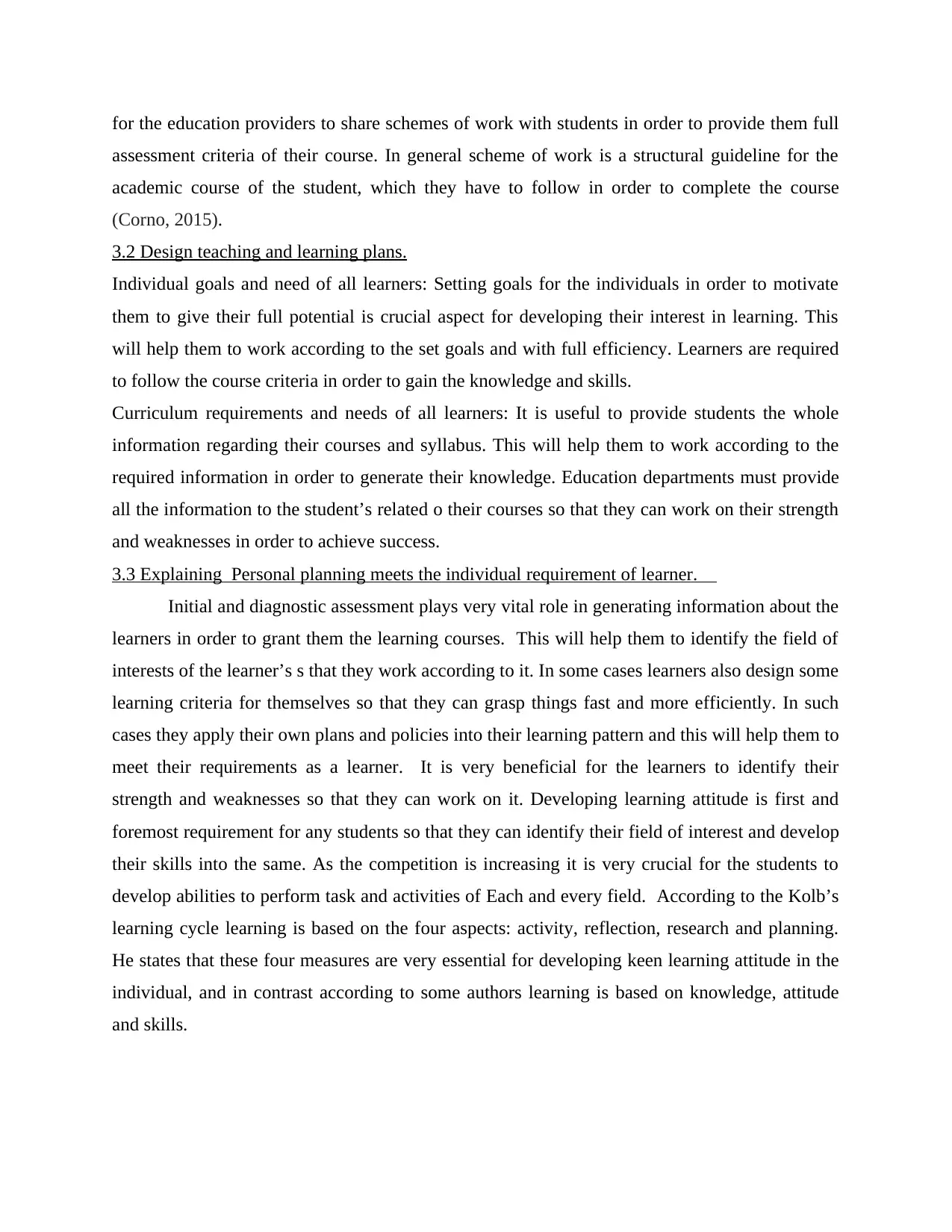
for the education providers to share schemes of work with students in order to provide them full
assessment criteria of their course. In general scheme of work is a structural guideline for the
academic course of the student, which they have to follow in order to complete the course
(Corno, 2015).
3.2 Design teaching and learning plans.
Individual goals and need of all learners: Setting goals for the individuals in order to motivate
them to give their full potential is crucial aspect for developing their interest in learning. This
will help them to work according to the set goals and with full efficiency. Learners are required
to follow the course criteria in order to gain the knowledge and skills.
Curriculum requirements and needs of all learners: It is useful to provide students the whole
information regarding their courses and syllabus. This will help them to work according to the
required information in order to generate their knowledge. Education departments must provide
all the information to the student’s related o their courses so that they can work on their strength
and weaknesses in order to achieve success.
3.3 Explaining Personal planning meets the individual requirement of learner.
Initial and diagnostic assessment plays very vital role in generating information about the
learners in order to grant them the learning courses. This will help them to identify the field of
interests of the learner’s s that they work according to it. In some cases learners also design some
learning criteria for themselves so that they can grasp things fast and more efficiently. In such
cases they apply their own plans and policies into their learning pattern and this will help them to
meet their requirements as a learner. It is very beneficial for the learners to identify their
strength and weaknesses so that they can work on it. Developing learning attitude is first and
foremost requirement for any students so that they can identify their field of interest and develop
their skills into the same. As the competition is increasing it is very crucial for the students to
develop abilities to perform task and activities of Each and every field. According to the Kolb’s
learning cycle learning is based on the four aspects: activity, reflection, research and planning.
He states that these four measures are very essential for developing keen learning attitude in the
individual, and in contrast according to some authors learning is based on knowledge, attitude
and skills.
assessment criteria of their course. In general scheme of work is a structural guideline for the
academic course of the student, which they have to follow in order to complete the course
(Corno, 2015).
3.2 Design teaching and learning plans.
Individual goals and need of all learners: Setting goals for the individuals in order to motivate
them to give their full potential is crucial aspect for developing their interest in learning. This
will help them to work according to the set goals and with full efficiency. Learners are required
to follow the course criteria in order to gain the knowledge and skills.
Curriculum requirements and needs of all learners: It is useful to provide students the whole
information regarding their courses and syllabus. This will help them to work according to the
required information in order to generate their knowledge. Education departments must provide
all the information to the student’s related o their courses so that they can work on their strength
and weaknesses in order to achieve success.
3.3 Explaining Personal planning meets the individual requirement of learner.
Initial and diagnostic assessment plays very vital role in generating information about the
learners in order to grant them the learning courses. This will help them to identify the field of
interests of the learner’s s that they work according to it. In some cases learners also design some
learning criteria for themselves so that they can grasp things fast and more efficiently. In such
cases they apply their own plans and policies into their learning pattern and this will help them to
meet their requirements as a learner. It is very beneficial for the learners to identify their
strength and weaknesses so that they can work on it. Developing learning attitude is first and
foremost requirement for any students so that they can identify their field of interest and develop
their skills into the same. As the competition is increasing it is very crucial for the students to
develop abilities to perform task and activities of Each and every field. According to the Kolb’s
learning cycle learning is based on the four aspects: activity, reflection, research and planning.
He states that these four measures are very essential for developing keen learning attitude in the
individual, and in contrast according to some authors learning is based on knowledge, attitude
and skills.
⊘ This is a preview!⊘
Do you want full access?
Subscribe today to unlock all pages.

Trusted by 1+ million students worldwide
1 out of 25
Related Documents
Your All-in-One AI-Powered Toolkit for Academic Success.
+13062052269
info@desklib.com
Available 24*7 on WhatsApp / Email
![[object Object]](/_next/static/media/star-bottom.7253800d.svg)
Unlock your academic potential
Copyright © 2020–2025 A2Z Services. All Rights Reserved. Developed and managed by ZUCOL.

